Welcome to the world of Social Selling, where selling isn’t just about numbers and charts – it’s also about a good dose of humor and an aerial mastery of social networks.
It’s a show where the product is not only the hero, but also the comic relief.
So fasten your seatbelts, adjust your hat 🎩 and let us take you on a journey where laughter is just as important as conversion.
Today’s menu:
- The definition.
- Why make them.
- The 6-step strategy.
- The 3 pillars.
- 4 tools for social selling.
Are you ready for the big trip? We’re off! ✈️
Social selling def
It’s a strategic sales approach that takes 🔫 advantage of social networks to build and maintain relationships with potential customers.
In reality, rather than focusing solely on traditional sales methods, social selling relies on the skillful use of platforms such as LinkedIn, Twitter, Facebook, or even Instagram. With the aim ⚽️ of proactively engaging customers, establishing the trust and thus influencing purchasing decisions. 🤑
This method involves many points (don’t worry, I’ll tell you what they are):
- The creation of relevant and engaging content.
- Sharing useful information.
- Establishing genuine connections with prospects.
The social seller (if you don’t know what that is, we talk about it later in the article, so be patient) seeks to become a trusted source by educating their audience and establishing a positive presence 🫶🏼 in online communities.
Social Selling Index: The Difference
This is not to be confused with the social selling index, which is linked to LinkedIn. In fact, their objectives are different:
- Social selling ➡️ aims to turn online interactions into sales opportunities by creating authentic relationships and using social media as a lead generation tool.
- Social selling index ➡️ evaluates the use of LinkedIn’s features for prospecting, relationship building, personal brand building and content publishing, in the form of a score based on these criteria.
To summarize, here’s a quick table. 👇🏼
| Criteria | Social Selling | Social Selling Index (SSI) |
|---|---|---|
| Methodology | Involves creating engaging content, sharing useful information and building authentic relationships across various platforms. | Use specific LinkedIn metrics, such as prospecting, relationship building, personal brand building and content publishing. |
| Performance Measurement | Typically measured by conversion metrics, engagement rates and network growth across multiple platforms. | Provides a specific numerical score on LinkedIn based on use of the platform’s specific features. |
| Applicability | Applicable to all social media platforms, suitable for various sectors and types of business. | Specific to LinkedIn, ideally used by those who have a significant presence on this platform and are looking to optimize their social selling strategy on LinkedIn. |
The benefits of social selling
There are several advantages to using it, and let’s find out what they are: 👇🏼
- Developing authentic relationships→ building longer-lasting relationships with potential customers.
- Access to a global social network→ reach customers beyond traditional geographical boundaries.
- Optimize the sales process→ personalize sales approaches.
- Strengthen personal brand→ share relevant content, demonstrating their expertise.
- Generate qualified leads→ understand prospects’ needs and adjust offers accordingly.
Nevertheless, it does have a few drawbacks, but we’ll briefly go over them. ✈️
- Information overload.
- Online reputation management.
- Platform dependency.
Why social selling?
When you make a purchase on the Internet, you prefer to know where the product comes from, and the more you trust the buyer, the more you want to go through with it, right? 😇
Well, it’s the same here. By engaging in important conversations about social networks, salespeople create trust 🫱🏽🫲🏼 fundamental to the sales process.
In practical terms, what does it do? 🤔
It amplifies the brand’s visibility, whether at the individual level for salespeople and for the company as a whole.

A word of advice: if you use 🔎 the data available on the various user profiles, you’ll be able to personalize your approach, improving the relevance of your interactions and accelerating the sales process. 📈
What is a Social Seller?
A social seller is a sales professional who uses social media as a central part of his or her business sales strategy.
In fact, it doesn’t just follow traditional methods. No, no, no, he integrates the principles of digital marketing and online communication in its approach. 🐾
Here, just for your eyes 👀, are some key skills a Social Seller should have:
- 1️⃣ Creation of attractive content.
- 2️⃣ Manage your online presence.
- 3️⃣ Understanding consumer behavior on social media.
- 4️⃣ Ability to establish authentic connections.
The social selling strategy in 6 steps
Now that you know what social selling is, it seemed obvious to us to detail how to carry out your strategy. ✨
That’s why we’ve condensed it into 6 steps. 😇
Without further ado, sit back and take notes: it’s time! 📝
1) Search for prospects
Searching for prospects is one of the most important steps in this strategy cornerstone of a successful strategy.
Well, yes, clearly defining your target audience 🎯 is essential. To achieve this, you can, for example, use the advanced search functions on certain social platforms, such as LinkedIn, to identify 🔎 relevant prospects.
Search filters can also be used to specify criteria such as :
- ⚙️ Industry.
- 📍 Geographic location.
- 🖥️ Professional skills.
- 👀 Specific companies.
Be careful with this practice, however: you need to effectively target prospects who are most likely to benefit from your products or services.
Okay, I know you like examples, so let’s blast 🧨 the example.
If you sell software solutions for small businesses, then you could target 🏹 technology professionals in medium-sized companies.
This is just an example, but you can also:
- Participate in discussions.
- Identify influential people.
- Engage with active community members.
2) Profile creation
Your social profile is often the first impression prospects will have of you. It should be a captivating showcase of your expertise and, above all, of your professional personality.
Yes, we all prefer to follow an engaging person with a strong positioning rather than a robot specially designed to sell us its product, right? 😌
To achieve this, start by taking care of your profile photo. Opt for a professional, welcoming image that inspires confidence (no photos with your cat, of course…). We want a quality photo that reinforces 🫱🏽🫲🏼 the human aspect.
Then, you can customize your summary for LinkedIn, biography or description, depending on the type of product you want to sell and which social network you use. Inside, don’t hesitate to highlight:
- 🥇 Your key skills.
- 🥈 Your professional experiences.
- 🥉 Your goals.
3) Profile optimization
Now that you’ve created your profile, it’s time to optimize it. 👀
To accomplish this, start by adding relevant keywords and impacting 💥 in your summary or biographies.
Why, you might ask? 🤔
Well, keywords are a bit like the compasses 🧭 of the search engines. They help to increase profile visibility.
But keywords alone are not enough: you must also add some of the skills that your customers are looking for targets are looking for. 🔎
Finally, don’t hesitate to ask for recommendations from colleagues, customers, or partners. 🫶🏼
4) Create persuasive content
Right, now we’re going to tackle the content! You’ll need to transform your online presence into a valuable source of information for your prospects. This is the time to share ideas, tips, and topics that captivate your audience and drive engagement. 🤩
Once you know who your audience is, you need to understand their needs, their challenges and interests. 👀
Whether in the form of articles, videos, carousels, photos or real life, always remember to adapt your language and examples to resonate with their senses.
A little friendly advice (we’re friends now, aren’t we?), be regular! Don’t hesitate to use an editorial calendar to keep your audience interested. To accomplish this, don’t hesitate to use the right tools. We’ll talk about them below. 😇
5) Engage your audience
This step goes well beyond the simple distribution of content, and involves an active dialogue and genuine participation. 💟
What you automatically have to do if you want to engage your audience is respond to comments and messages directly (we agree, not at the second ready).
This shows your prospects that behind an account is a real person. 👀
As a friend (after all, we are, aren’t we?), here are a few tips you can apply:
- 🔵 Participate in relevant conversations.
- 🟣 Explore groups.
- 🔵 Integrate forums.
- 🟣 Exchange ideas in discussions related to your business industry.
- 🔵 Comment on other professionals’ publications.
- 🟣 Offer useful advice.
For example, you can use features such as the surveys or any other type of question on social networks to solicit the opinion of your audience. This will create an opportunity for dialogue and make your prospects feel heard and involved in the process. 😇
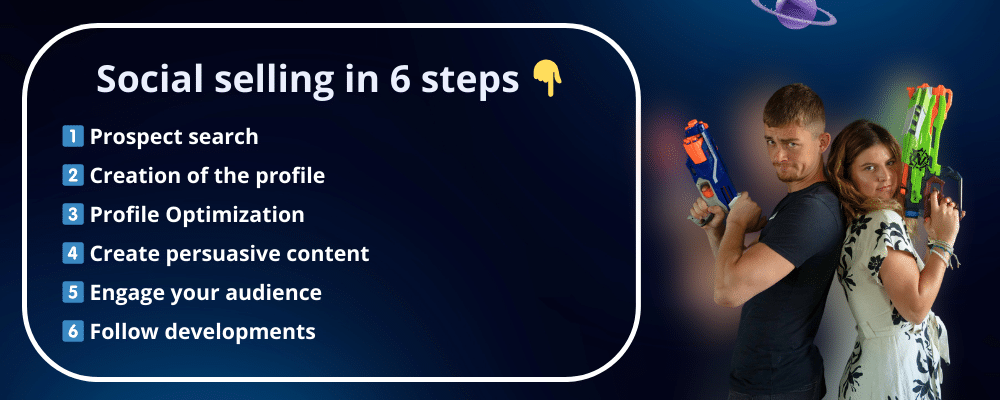
6) Monitor developments
This last step is all about staying nimble, adjusting your approach to changes in your industry, on social media and in the purchasing behavior of your audience. 🤑
An essential aspect of monitoring developments… 🥁 The competitive intelligence!
You owe it to yourself to stay informed about the activities of your competitors on social networks by analyzing their strategies or identifying their emerging trends, for example. This will enable you to adjust yours accordingly. 🤫
Be careful, though, as social networks regularly update their algorithms, which can drastically influence the visibility of your content. 👀
We therefore recommend the use of analysis tools that will enable you to measure the effectiveness of your strategy. We’ve listed a few below. ⬇️
Well, it’s all very well to keep track of developments, but where do we stand? Performance indicators, should we base ourselves on? 🤔
Well, that’s what we’re going to find out right now! 👇🏼
Which KPIs to track?
Without further ado, here are a few key performance indicators:
- Media engagement
Tracking Key Performance Indicators (KPI) in a Social Selling strategy is essential to evaluate the effectiveness of your efforts and optimize your approach. Here are a few relevant KPIs:
- 1️⃣ I love it.
- 2️⃣ Sharing.
- 3️⃣ Comments
- 4️⃣ New subscribers
- 5️⃣ New connections.
- 6️⃣ Total reach of your publications.
- 7️⃣ Number of prints.
Keep this in the back of your mind 🧠: a regular analysis of these metrics will help you refine your Social Selling strategy.
What are the 3 pillars of social selling?
Did you know that social selling is based on 3 pillars? No? Well, yes! Well, not like Parthenon, but it’s all the same. 🏛️
We’ll explain it right away! ⬇️
1. Trigger selling
Trigger marketing means triggered selling, and is based on the idea 💡 that certain events or triggers can signal a sale or potential need with a prospect.
These triggers can be:
- Organizational changes.
- Product launches.
- Industry events.
- Publications on social media.
It is divided into 3 parts: 👇🏼
1️⃣ Trigger monitoring.
Use intelligence tools to monitor changes in your prospects’ businesses. This includes personnel changes, project announcements, or even key events. 🔑
2️⃣ Immediate reactivity.
As soon as a trigger is identified, don’t hesitate to act quickly. To do so, contact a lead to meet its new needs.
3️⃣ Personalized approach.
Show that you are aware of the specific change in their business and explain how your solution can be the answer.
2. Insight selling
Secondly, Insight Selling involves providing ideas or insightful information that stimulates reflection in the customer. Prospect to help them better understand their needs and challenges. ⚔️
This involves positioning your company as a strategic advisor capable of bringing real added value.
Here are 3 points to consider. 👇🏼
1️⃣ Profound understanding.
You need to understand your prospect’s specific issues beforehand. Thorough research into the company and the challenges they face. 🥊
2️⃣ Identifying pain points.
These ideas must be based on an in-depth understanding of their situation and offer new perspectives or innovative solutions.
3️⃣ Persuasive communication.
Use concrete examples, case studies and, above all, relevant data to support your arguments.
Here, the whole point is to convince the prospect that your solution is the best one for their needs.
3. Referral selling
Finally, the last pillar, aka referral selling. It’s based on the powerful principle of word-of-mouth. 🦻🏼
Indeed, rather than actively seeking new prospects, the seller solicits recommendations from customers or other contacts in his network. 🌐
You know the song 🎶, it’s also based on 3 points.
1️⃣ Cultivating strong relationships.
Make sure they’re satisfied with your products or services, and that they trust your expertise. 🫱🏽🫲🏾
2️⃣ Ask for recommendations.
Formally, you can make a request through a sponsorship program or informally, by asking your contacts directly if they know someone who could benefit from your services. ✨
3️⃣ Personalize tracking.
Mention the person who made the recommendation, explain how your product or service can be of particular benefit to the person who made the recommendation. And explain how your product or service can be of particular benefit to the person who made the recommendation. New prospect and above all, strengthen the connection 💟 with a little personal presentation.
Need a summary? This visual is your best friend. 😇
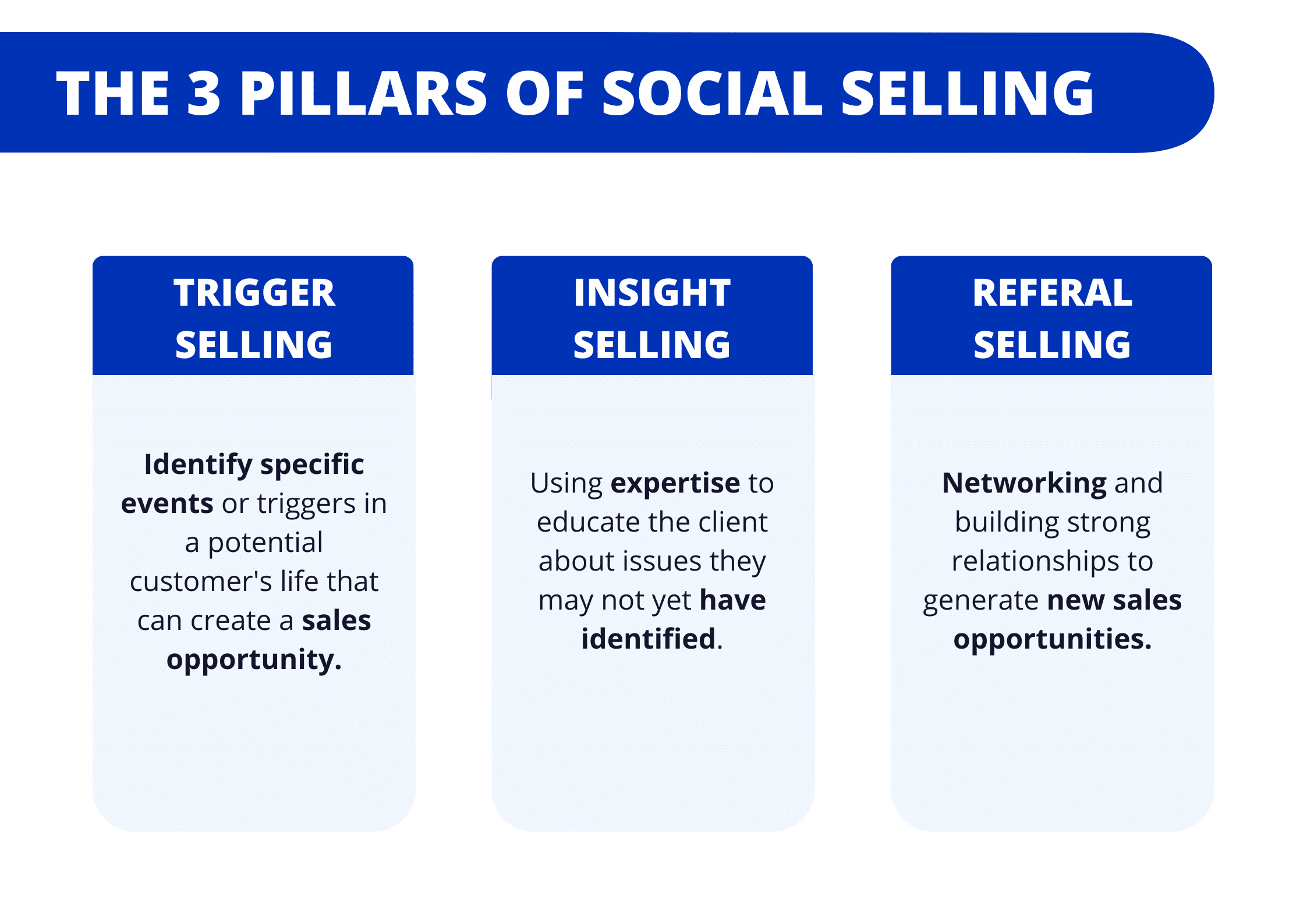
4 Tools for Social Selling
Now that you’re an expert in the field of social selling, we thought we’d show you a few tools to make your social selling easier. strategy. What do you think? 😇
Come on, each tool will help you improve your marketing to become an ace 🃏 of Social Selling! ✨
1. Hootsuite: Social Media Management
Hootsuite has positioned itself as an indispensable 💪🏼 ally in this process. If you’re not familiar with it, this tool lets you manage and schedule publications on different platforms such as LinkedIn, Facebook, and many others.
It offers the following features: ⬇️
- 🟠 Programming publications.
- 🟠 Real-time monitoring.h
- 🟠 Followed by brand mentions.
- 🟠 View conversations.
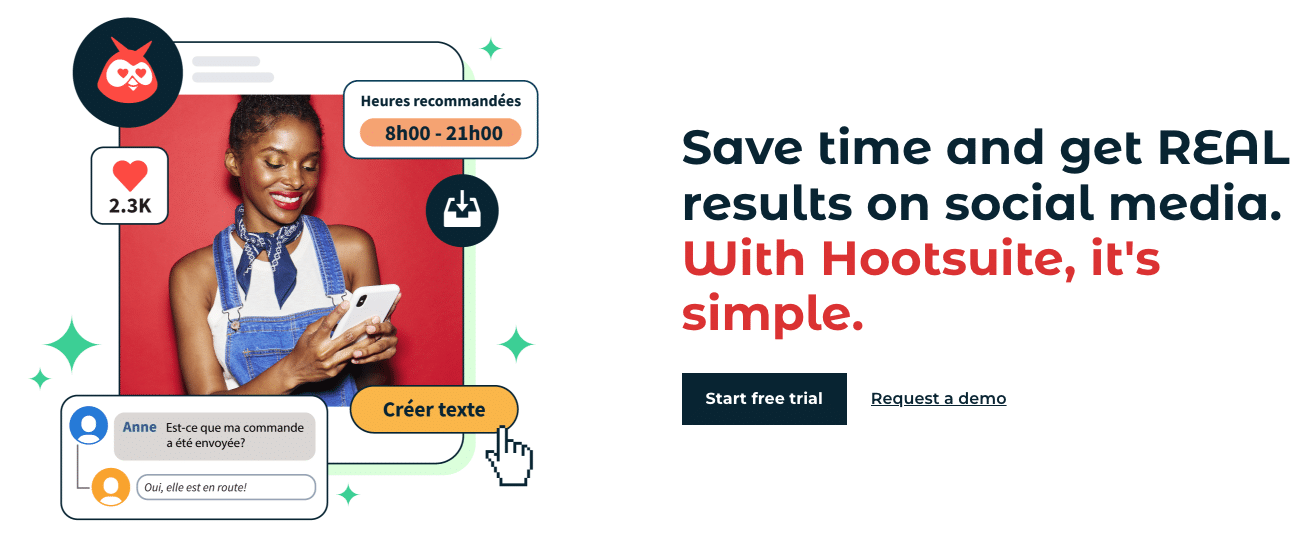
2. Canva: Graphic Design
I’m not telling you anything new, graphic design is a key 🗝️, let’s say primordial element of Social Selling. 💙
Whether you need to create publications, infographics or banners, with Canva you have a multitude of ready-to-use models and other tools to personalize content.

In this way, you’ll be able to reinforce the impact of your online presence by sharing visually captivating content. 🤩
3. HubSpot: Marketing Sales
HubSpot is an all-in-one tool ⚒️ that combines:
- ⚫️ Lead management tool.
- ⚫️ Marketing automation.
- ⚫️ Interaction tracking.
In fact, this tool allows you to track prospects’ interactions on social media, automate targeted campaigns 🎯 and, above all, measure the effectiveness of the efforts made.
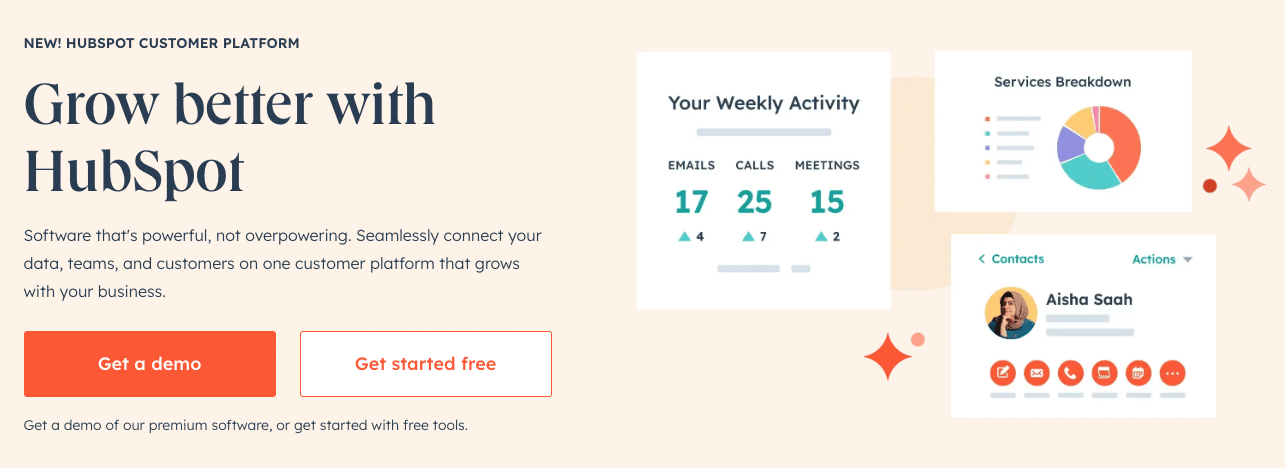
Finally, it offers a holistic view of the customer path, this makes our actions more coherent and effective. 🤺
4. Google Analytics: Conversion Tracking
And finally, Google Analytics! It’s a powerful tool for tracking conversion from social media to the website.
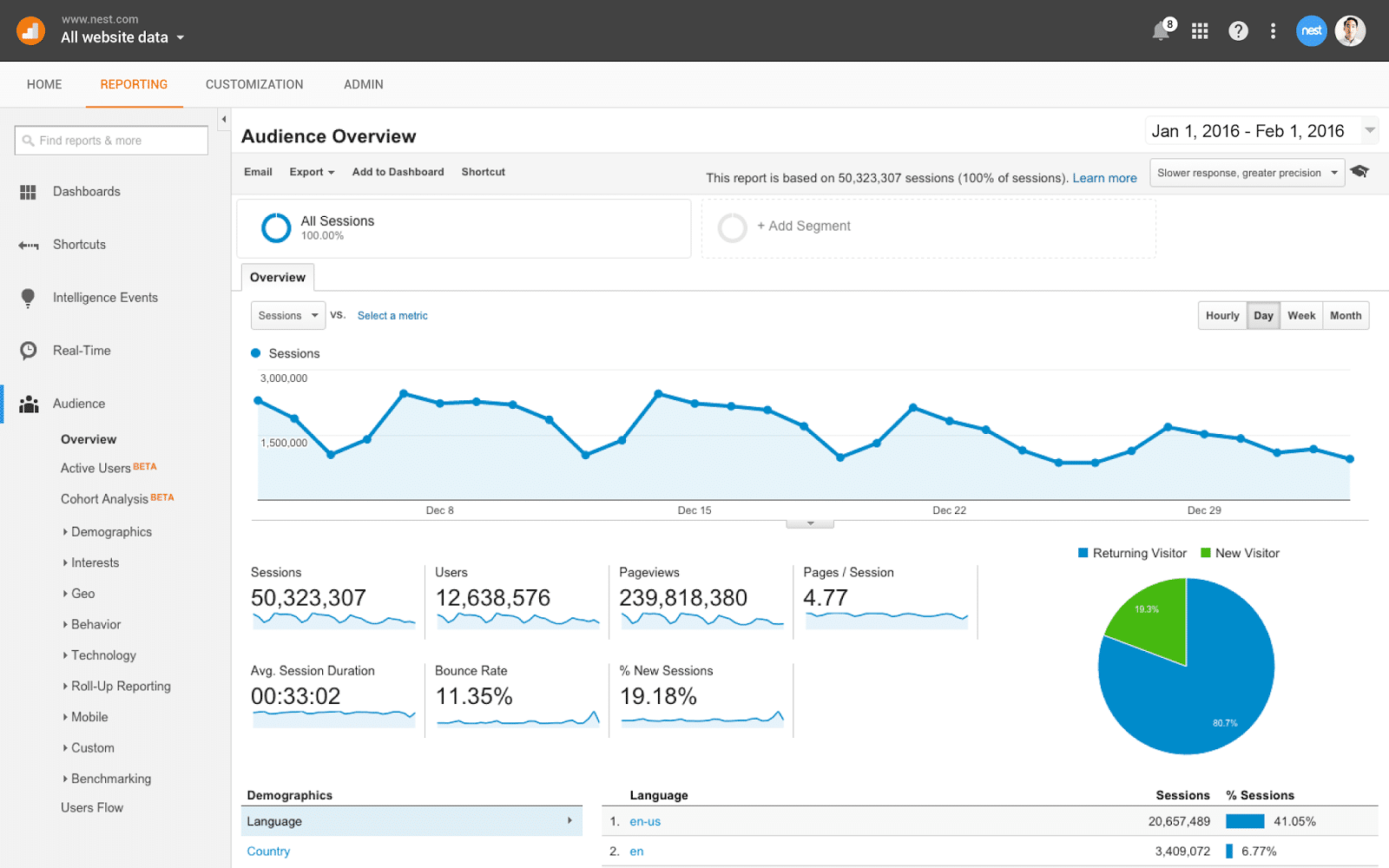
Indeed, by configuring specific goals and tracking traffic sources, this tool helps to understand which platforms generate the most engagement, what content resonates best and how prospects interact with the site after being exposed to social networks. 👀
➡️Want to find out more? Discover 12 social media management tools !
How about a recap?
Yes, it’s almost the end of this article… What did you learn from it? 😇
If I can add anything else, it’s that Social Selling is emerging as a dynamic strategy, reinforced by essential tools that optimize the management of social networks graphic design, sales-marketing integration and, above all, conversion tracking. 🦋
Frequently Asked Questions
Wait, don’t go yet! We have a few more resources to share with you. ⬇️
Who uses Social Selling?
Here’s a list of categories of people and companies who use the social selling:
- Sales professionals.
- Marketing professionals.
- Contractors and freelancers.
- B2B and B2C companies.
- Human resources professionals.
- Consultants and experts.
- Business development teams.
What are the limits of social selling?
Nevertheless, social selling does have a few limits and challenges. Here are just a few of them:
- Time and commitment.
- Content saturation.
- Dependence on algorithms.
- Privacy management.
- Training and adaptability.
- Conversion difficult to measure.
What’s the difference between traditional prospecting and social selling?
If you’re wondering what the difference is between social selling and prospecting. Well, here’s a table that sums it all up! ⬇️
| Features | Classic prospecting | Social Selling |
|---|---|---|
| Communication method | Telephone calls, unsolicited e-mails, personal canvassing. | Main use of social media (LinkedIn, Twitter, etc.). |
| Approach to Relationships | Perceived as more intrusive, focused on direct sales. | Emphasis on building long-term relationships before direct sales. |
| Use of Social Media | Complementary use, but not focused on social media. | Strategic use of social media as a key interaction platform. |
| Content and added value | May lack a value-added approach, often focused on direct presentation of products or services. | Focuses on creating and sharing value-added content to educate and inspire. |
| Monitoring and measurement | Tracking is sometimes more difficult to measure precisely. | Use social media tools to track engagement, measure reach and analyze results. |
Now you know all about social selling! See you soon. 👋🏼












